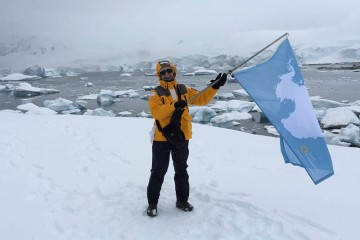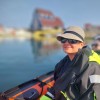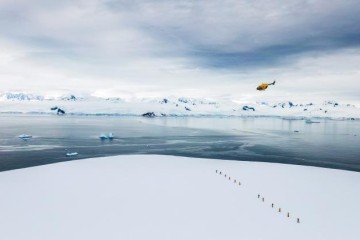A severe bout of seasickness is about the only thing that could dampen your spirits on an expedition cruise to Antarctica. While most seafaring explorers are thrilled by the prospect of crossing some of the world's remotest and most infamous passages, others feel queasy at the mere thought of navigating stormy open seas. For those inherently prone to seasickness, an adventure-filled expedition to the far south can be daunting.
If you are one of those travellers prone to motion or seasickness, we're here to help. We've collated the top tips for dealing with seasickness, and, to do this, we've brought in the big guns: the most seasickness-prone crew member here at Viva and one with an abundance of expedition expertise.

Tara in Antarctica.
Meet Tara, Viva’s Operations Manager. Tara LOVES Antarctica expeditions, has been on several, dreams of penguins and icebergs daily, and tries to return to the icy continent every chance she gets. Tara thinks expeditions to Antarctica are the ultimate bucket-list experiences. Unfortunately, Tara is also hopelessly prone to seasickness. Yet her love of expeditions and Antarctica has meant she has found myriad ways to keep the green-gilled monster at bay on her explorations.
Over the years, Tara has helped hundreds of clients plan and enjoy their Antarctic adventures to the fullest. We couldn’t think of a better person to guide us through a seasickness avoidance course!
Alongside Tara’s top tips, here’s what we’ll cover in this guide:
- Seasickness on Antarctica expeditions – where are the biggest risks?
- Expedition cruises from South America – dealing with seasickness on the Drake Passage
- Expedition cruises from New Zealand – dealing with seasickness on the Ross Sea
- Tara’s top tips for dealing with seasickness
- Use several anti-seasickness remedies, simultaneously
- Jump the gun and get ahead of the seasick beast
- Choose the right medication for you – and do a trial run before travelling
- Limit stimulants during the roughest crossings
- Ginger is your best (anti-seasickness) travel companion
- Keep dry crackers on you at all times
- Don’t fast
- Take plenty of (anti-stimulating) rest
- Head to the outer deck for a breath of fresh air
- Find your happy place
- Make sure to pack rehydration salts/electrolytes
Seasickness on Antarctica expeditions – where are the biggest risks?
First, some good news: seasickness is certainly not a given on every expedition cruise to Antarctica. Moreover, not everyone is predisposed to this condition. Some people can tackle a rough sea cruise like an exhilarating roller coaster ride. Kudos to them! If you're not that lucky, however, what helps most is to know where and when you’ll be facing your biggest seasickness challenges. Why? From Tara’s tips, detailed further on, you’ll learn that the best way to deal with seasickness is to be proactive.
Expedition cruises from South America – dealing with seasickness on the Drake Passage
If you embark on an expedition cruise to Antarctica from South America, your seasickness hot spot is the Drake Passage, the infamous 'roughest sea' on Earth. The Drake floats between South America and Antarctica. Because there are no significant landmasses across the globe at that latitude, winds and sea currents are allowed to run rampant. Sometimes, they really do!
Crossing the Drake Passage takes two days, one way. As soon as you navigate through the calm Beagle Channel, you enter the passage and have about a 50/50 chance of dealing with rough seas for the next 48 hours. Half the time, the Drake is blissfully calm, and the crossing is an absolute delight of marine life spotting and cruising enjoyment. After reaching the Antarctic Peninsula, you'll be in relatively calm waters, which don't usually cause seasickness in cruise passengers.
Insider tip – Some seasickness sufferers choose to skip the Drake altogether – preferring to fly to King George Island, thus bypassing the passage and picking up their cruise just north of the Antarctic Peninsula. This option is viable for anyone who gets a little green around the gills, even on a 10-minute ferry ride in a calm bay. See our blog Is it Better to Fly or Cruise to Antarctica?
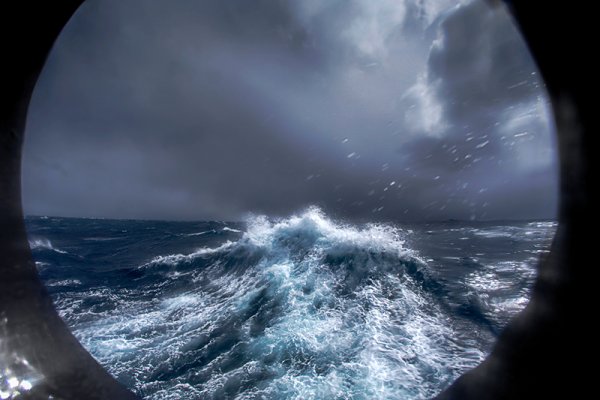
The Drake Passage connects the Atlantic and Pacific oceans. It takes around 48 hours to cross it by expedition ship, and two hours to fly right over it.
Expedition cruises from New Zealand – dealing with seasickness on the Ross Sea
When travelling to Antarctica from New Zealand, you'll embark on one of the world’s most epic seafaring voyages. These month-long adventures include a whole first-week crossing open seas to reach East Antarctica, the remotest and least visited side of the White Continent. There, you’ll be in the Ross Sea, which can be notoriously rough of its own accord.
Unfortunately, you cannot fly to Antarctica from New Zealand and skip the Ross Sea. On these longer, more immersive expeditions, avoiding seasickness is paramount.

The Ross Sea is a marine wildlife haven, home to over one-third of all penguin species and almost 50% of the world’s Weddel seals. The Ross Sea Ice Shelf is the world’s largest and a major highlight on Antarctic expeditions from New Zealand.
The good news is that most people adjust to seasickness within 24 hours of casting off. Once your body acclimatizes to motion, it will be improbable that you will continue to feel nauseous beyond day 2. The key is to keep up with anti-seasickness medication for the duration of the trip, regardless.
Now that you know where you will likely encounter the roughest seas on Antarctica expeditions, it’s time to discover the best tricks of the trade to keep seasickness at bay.
See Viva’s Antarctica Cruises from New Zealand / Australia.
Tara’s top 10 tips for dealing with seasickness
Use several anti-seasickness remedies, simultaneously
When dealing with seasickness, Tara says the best tactic is to use various antidotes simultaneously. The more you adopt, the higher your chance of keeping all your insides on the inside. It’s also about acting fast, before seasickness even has a chance to get a look-in.
Jump the gun and get ahead of the seasick beast
According to Tara, the key is to prevent seasickness before it takes hold. You'll win the battle if you can manage to hold off the BIG stuff from the get-go (like severe nausea and vomiting). If the weather forecast isn't looking great or you suspect you might easily suffer seasickness, start taking your medication after dinner on the evening before departure. Don’t wait until you feel sick to do something about it – antidotes will have to work much harder to make you feel a-ok.
Choose the right medication for you – and do a trial run before travelling
Tara swears by promethazine – a first-generation antihistamine that is proven to block the receptors responsible for motion sickness. Antihistamines are not traditionally used for motion sickness, but they are renowned for being exceptionally effective – because if it's good enough for NASA, it’s good enough for us!
We recommend you speak to your doctor or pharmacist before travelling to find the perfect anti-nausea medication that works for you. Nowadays, you'll find an array of tablets, patches, drinks, drops, and even wristbands designed to help you deal with seasickness. Some medications can cause undesirable side effects, so if trying something for the first time, it might be wise to do a trial run at home to see how you react. The last thing you want on an expedition cruise is to deal with two problems, so find the best medication for you before going anywhere.
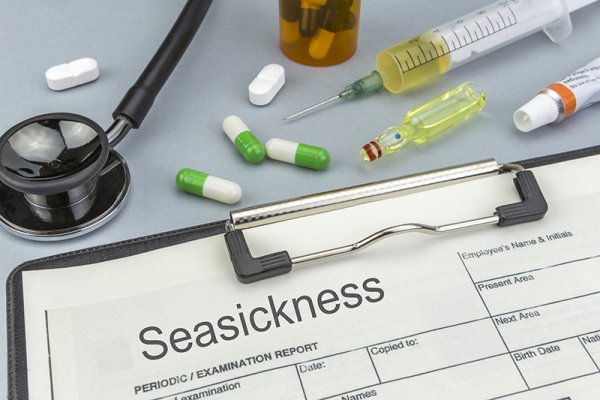
There’s a world of seasickness medication out there – speak to your doctor or pharmacist to find the one that’s right for you.
Limit stimulants during the roughest crossings
Limiting your coffee and alcohol intake during rough sea crossings goes a long way in dodging seasickness. Don't worry; you'll have plenty of time to enjoy both once you are cruising Antarctica proper – just skip them during the Drake or Ross Sea crossings, and you'll help prevent seasickness. This is arguably the #1 thing to avoid to dodge severe seasickness on Antarctica expedition cruises.
Ginger is your best (anti-seasickness) travel companion
Tara says ginger and peppermint are the natural superheroes of her fight against seasickness. Ginger is undoubtedly a proven anti-nausea remedy and can be taken dry (Tara loves to chew on dry ginger from the moment she's underway) or as a tea or ginger ale drink. Tara is also partial to ginger and peppermint tea (believes the combination of the two works a treat) and finds green apples – in particular – also do a great job of keeping nausea at bay.
Keep dry crackers on you at all times
Anyone easily nauseated will probably already know the benefits of munching on dry, salty crackers. Among the things to pack to avoid seasickness include plenty of saltines (alongside your dry ginger and anti-nausea medication) as well as dry banana chips and nuts. The latter two will help keep your energy levels up while you arguably consume fewer calories from complete meals and are also known to help against nausea.
Don’t fast
It might seem counterintuitive to the unaccustomed, but seasickness experts will tell you that cruising on an empty stomach is a big no-no. You might reason that if there's nothing in your stomach, what could you possibly vomit? But your stomach juices will prove you wrong. The trick is to put a little something in your stomach, but not too much. Those saltines and a few pieces of dry ginger are just what the doctor ordered.
Take plenty of (anti-stimulating) rest
One of the most effective seasickness remedies is to lie down, put on a sleeping mask and earplugs, and take some time out from overstimulating sights, sounds and smells. That means no reading or watching movies on an I-pad! Since motion sickness derives from the misfiring of messages (your eyes say you're not moving, but your body feels otherwise), dulling a couple of senses goes a long way in mitigating the effects of cruising. Even if you don’t manage to sleep, this kind of rest can be even more effective than any other kind of medication out there.
Head to the outer deck for a breath of fresh air
A big lungful of fresh air does wonders against nausea. Mind you, if you’re crossing the Ross Sea mid-storm, the beneficial effects might be counteracted. Wait for a calm moment and get out of the at-times stuffy indoors, and you're guaranteed to feel much better. Looking out to the horizon is also a fantastic antidote to motion sickness because your eyes, body and brain can finally all agree: you ARE in motion!
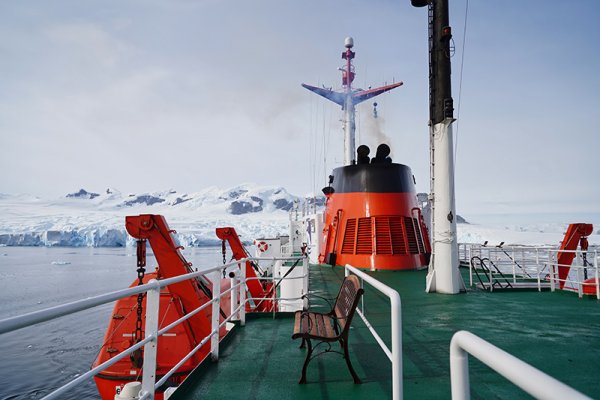
The fresh air and stellar views will make you feel a whole lot better.
Find your happy place
On an expedition ship, your happy non-nauseating place – and the calmest point – will be somewhere smack-bang in the centre. Usually, cabins are aligned on either side of the ship so a central location might be a reading room. Now, you will not want to be doing any reading, but this is the perfect spot to put on your headset and listen to some relaxing music.
And if ALL these tips fail to starve off seasickness on your Antarctica expedition cruise…
Make sure to pack rehydration salts/electrolytes
Dehydration is a debilitating consequence of seasickness. If you do get sick, taking rehydration salts will help you recover quickly. To be honest, many anti-seasickness medications also cause dehydration so if you develop a headache, it’s a good idea to add some Hydralyte to your drinking water anyhow.
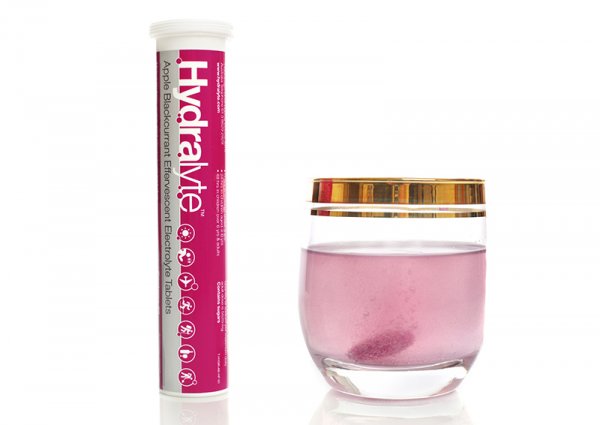
Hydralyte helps keep you hydrated with or without seasickness.
We hope Tara’s top tips for dealing with seasickness will help you prepare for your extraordinary expedition without any anxiety or stress. Once you build your own 'arsenal of anti-seasickness remedies', you can cast off on an expedition and feel confident you'll enjoy the absolute adventure of a lifetime.
Contact our Destination Specialists to learn more about upcoming expedition cruises to Antarctica.
Laura Pattara
Laura Pattara has spent more than a decade writing about polar cruising at Viva Expeditions. While she has not yet set foot on the southern ice herself, she has mastered the art of turning expert accounts and field notes into guides that feel like the next best thing. Laura has a soft spot for penguins, perfectly packed duffel bags, and a well-earned cocktail in a wild place.
|
